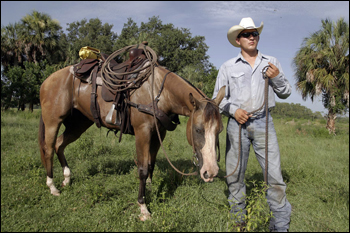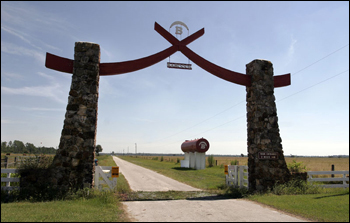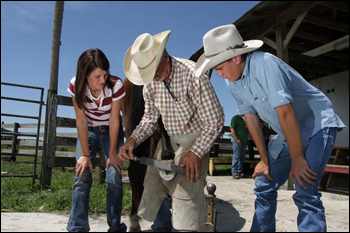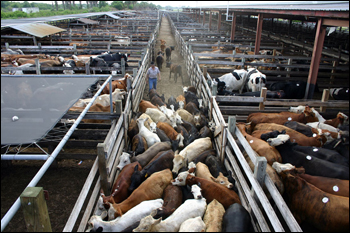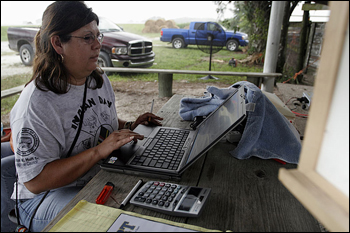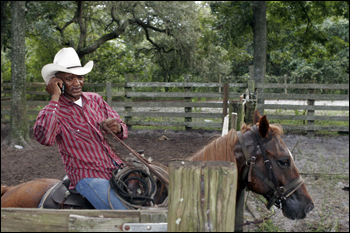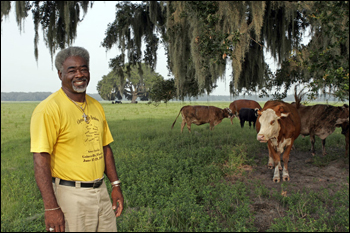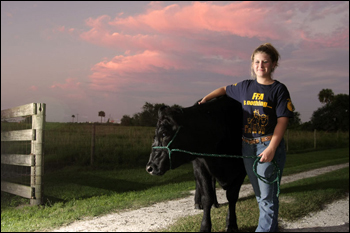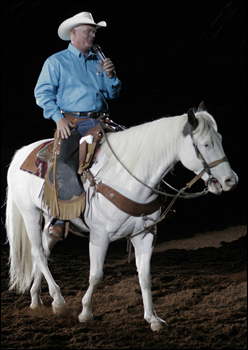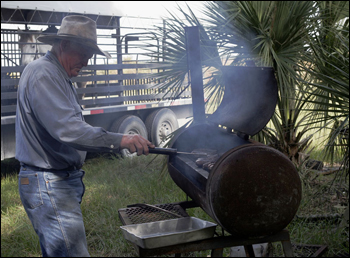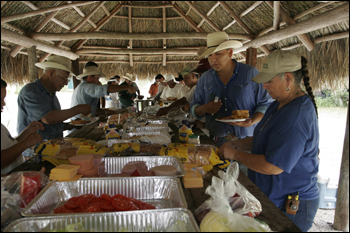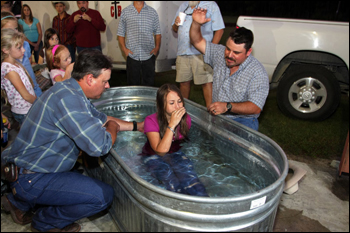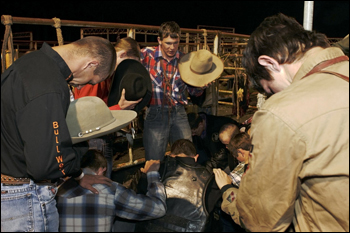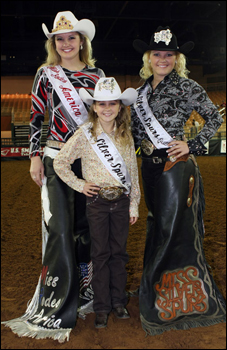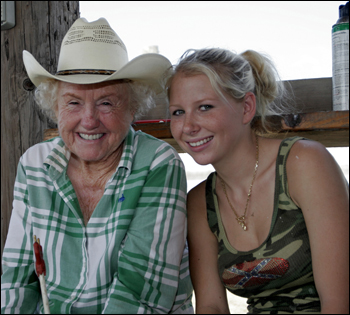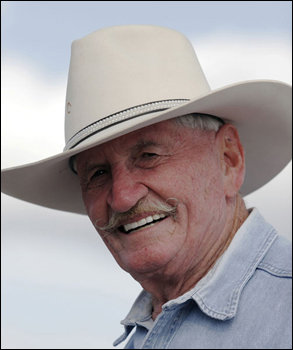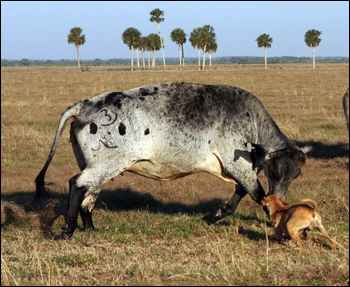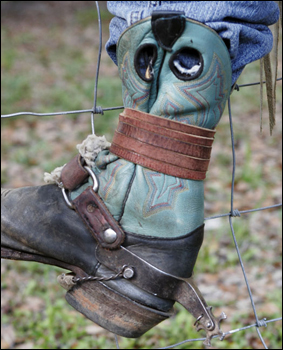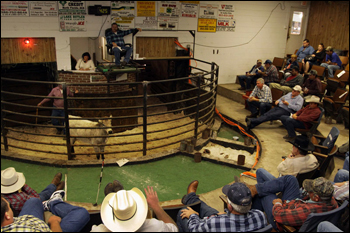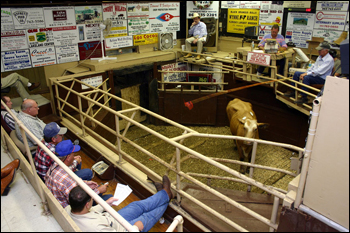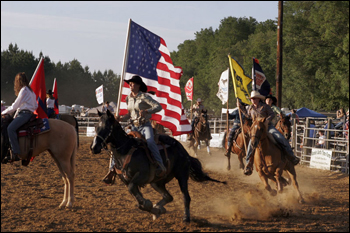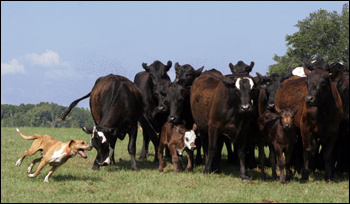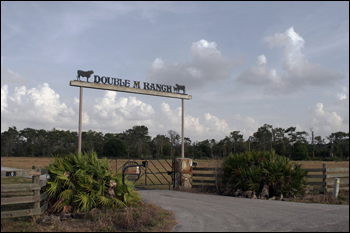Photo Exhibits
Photo exhibits spotlight various topics in Florida history, and are accompanied by brief text intended to place selected materials in historical context.
Florida Cattle Ranching
Traditions and Innovations: Florida Ranching in the 21st Century
Justin Gopher with Cracker horse. Big Cypress Seminole Indian Reservation, July 2007.
Image Number: FS060827
Justin Gopher takes a break during the annual roundup. The small, agile horses descended from stock introduced by the Spanish in the 16th century make exceptional ranch horses. Seminoles and non-Indians have used them for centuries. In 2008, the Florida Legislature declared the Florida Cracker Horse the state's official heritage horse.
Babcock Ranch gates. Charlotte County, September 2006.
Image Number: FS060832
The ranch's Crescent B brand is displayed in this unique ranch entryway design fashioned from native limestone, metal, and wood.
Hoof trimming lesson. Okeechobee, September 2008.
Image Number: FS060823
Okeechobee High School students Kayla Davis and Matthew Dorriety watch closely as Agricultural Science teacher Roger McWaters shows them how to trim and dress a horse's hoof.
Cattle Ranching in the 21st Century
In January 2008, there were over 1.7 million cattle in Florida, including nearly 1 million head of beef cows. Florida was 12th in the nation for beef cattle and 18th for total cattle and calves. Industry officials assess the annual economic impact of beef cattle ranches at nearly $4 billion.
Buyers' pens, Okeechobee Livestock Market. Okeechobee, May 2004.
Image Number: FS060835
About 2,500 head of cattle per week are auctioned, one at a time, at the Okeechobee Livestock Market. The cattle are then sorted into pens designated for each buyer. The day after an auction, the pens are emptied and the cattle are loaded into trucks and shipped.
Leoma Simmons at laptop computer. Big Cypress Seminole Indian Reservation, July 2007.
Image Number: FS060804
The Seminole Tribe of Florida uses the latest technology in their cattle operation. All their cattle are fitted with electronic ID tags, which track all aspects of the animal's history. Cattle are weighed on digital scales, marketed by video auction, and tracked using sophisticated software.
Tom Everett, Sr. with cell phone. Sumter County, September 2006.
Image Number: FS060801
The cell phone has become an indispensable means of communication for cattlemen. Ranch life is shaped by changing technology. Research continues to improve fertility, breeding, pasture management, and other factors that result in more efficient beef production.
Customs
Traditional customs are embedded in the daily life and special events of Florida's ranching community. Foodways, for example, often reflect southern roots. Rice and tomato gravy, cornbread, catfish and hushpuppies, okra, beans, barbeque, and swamp cabbage are favorite dishes. Swamp cabbage, called taal-holelke by the Seminoles, is a symbol of cultural identity.
Lewis Clayton. Gainesville, June 2006.
Image Number: FS060818
Lewis Clayton raised crops and hogs before he began cattle ranching on Kanapaha Prairie, Gainesville.
Kaley Dees with cow. Okeechobee, September 2008.
Image Number: FS060819
Okeechobee High School junior Kaley Dees at her family ranch with the registered Angus heifer she shows in FFA and 4-H events. She aspires to become a large animal veterinarian.
Rodeo announcer. Kissimmee, February 17, 2008.
Image Number: FS060817
Mounted on a beautiful medicine hat paint horse fitted with a fancy saddle, announcer Jerry Todd welcomes the audience to the 120th Semi-Annual Silver Spurs Rodeo.
Oral Traditions
Oral traditions encompass a variety of expressions, such as cowboy poetry, rodeo announcing, auctioneering, and personal experience narratives which become traditional after many tellings. Cowboy poetry borrows from such sources as folk poetry and song, popular poetry, historical writing, fiction, film, and television. Florida cowboy poets express a wide range of themes through verse. Poems may vividly describe the rugged and beautiful landscape, recount memorable events, or express the excitement and frustrations of everyday life. Most repertoires include a considerable amount of humorous material. Cowboy poetry is a popular part of many events that showcase Florida heritage.
VIDA Ranch barbecue, Osceola County, November 2007.
Image Number: FS060816
Norman Waters cooks country sausage links on a homemade barbecue grill for the VIDA Ranch crew lunch.
Seminole round-up lunch. Big Cypress Seminole Indian Reservation, July 2007.
Image Number: FS060822
Under the shade of a thatched chickee, cowboys and other workers share a lunch provided by the cattle owners whose herds are being rounded up and shipped. Men in light cowboy hats (left to right): Joe Osceola, Sr., Alex Johns, Paul Bowers, Wilson Bruised Head. Woman right foreground: Mary Jene Koenes. Man in camouflage ball cap and white tee shirt, right: Earl Kirkland. Others unidentified.
Baptism at Cowboy Church. Williston Horseman's Park, October 2008.
Image Number: FS060828
Pastor Billy Keith (right) of Cross Brand Cowboy Church baptizes Amber Thompson in a cattle trough.
Auctions
Auctions are a traditional setting for buying and selling cattle and ranch horses. Cattle auctions are held once or twice weekly at several locations throughout the state. The Okeechobee Livestock Market is one of the largest east of Texas. At the typical livestock market, cattle are directed to an auction ring surrounded by seated buyers. As the auctioneer solicits bids through his rapid patter, the animal's weight is displayed on a large screen. Bidders communicate by hand signals, the auctioneer announces the number of the winning buyer, and the animal exits the auction ring. An animal is often in the auction ring less than ten seconds. Livestock markets also provide an opportunity for networking and socializing among the cattlemen. In recent years cattle sales through Internet auctions, satellite television, and video have become increasingly popular with ranchers who own large herds of uniform calves. Since most Florida cattle are owned by small-scale ranchers, there remains a need for livestock markets where cattle are auctioned individually.
Praying bull riders. Williston Horseman's Park, March 2007.
Image Number: FS060803
Stephen "Preacher" Keighley leads fellow bull riders in an extended prayer behind the chutes at the annual Bull Mania.
Rodeo Queens. Kissimmee, February 2008.
Image Number: FS060825
Left to right: Amy Wilson, Miss Rodeo America; Ryleigh Tyson, Little Miss Silver Spurs; and Samantha Roberts, Miss Silver Spurs, at the Silver Spurs Arena.
Iris Wall with granddaughter Whitney Edwards. Indiantown, September 2006.
Image Number: FS060812
2006 Woman of the Year in Agriculture Iris Wall owns the High Horse Ranch in Indiantown. Her granddaughter, Whitney Edwards, a hairdresser, often helps her with cattle work.
Portrait of poet cowboy Carl Sharp. Kenansville, December 2006.
Image Number: FS060831
Carl Sharp's talent for cowboy poetry performance has made him a popular entertainer at cattle association meetings and cowboy gatherings throughout Florida and across the United States.
"Cowboy Church"
Many members of Florida's cattle ranching community are devout Christians. Worship and prayer is an integral part of family life, rites of passage, public events, and community meetings. At rodeos, opening ceremonies include a Christian prayer, and contestants may pray prior to competing. "Cowboy church" is a popular form of worship tailored to cowboys, ranchers, and members of agricultural communities. Prayers may reference horses, cattle, and ranch work. Worship services are held at rodeo grounds or other outdoor facilities. Rodeos often provide Sunday morning cowboy church for traveling contestants, and contestants commonly include Christian or cowboy church motifs on their apparel and equipment.
Working cow-dog. Okeechobee, January 2008.
Image Number: FS060848
A yellow cur cow-dog aggressively confronts a cow that has broken from the herd on the Dixie Ranch.
Boot and spur of bull rider Stephen Keighley. Williston, 2007.
Image Number: FS060808
Bull riding spurs are fastened tightly to the boot with a padded leather strap and held firmly with a twisted wire wrapped under the boot. A leather thong wrapped tightly around the boot top secures the boot to the foot.
North Florida Livestock Market. Ellisville, January 2009.
Image Number: FS060809
A buyer (foreground, white hat) signals his bid by raising his hand in response to the patter of auctioneer Aubrey Bailey (background center). The calf's weight of 425 pounds is displayed above the auctioneer.
Okeechobee Livestock Market
Image Number: FS060845
The auctioneer (white cowboy hat, center) is Tommy Stewart. Pete Clemons, market owner and retired rodeo champ, is sitting on the right with the prod.
Preservation and Teaching
The efforts of dedicated individuals and organizations have ensured the future of Cracker cattle and horses. In 1970, Florida's Department of Agriculture and Consumer Services began working with the Florida Cattlemen's Association to preserve Cracker cattle. Formed in 1988, the Florida Cracker Cattle Association and Florida Cracker Horse Association adopted breed standards and appointed evaluation committees to select animals to be registered as foundation stock. Although they lack broad-based commercial value, Cracker cattle are prized as tangible links to the state's rich ranching history. Cracker horses are widely popular because they can be trained for all riding disciplines and make excellent ranch horses.
Several organizations provide young people with training and experience. In addition to vocational agriculture courses in middle and high schools, FFA (formerly Future Farmers of America) and 4-H offer extra-curricular activities that teach the business of raising cattle and develop leadership skills. Industry organizations provide programs such as Junior Cattlemen, the Cattlemen's Sweetheart, and Beef Ambassadors, while the Seminole Tribe has summer co-op programs for interested students.
Grand Entry. Williston, April 2007.
Image Number: FS060844
Carrying the American flag, Ashley Mills leads girls on horseback bearing colorful flags to create a dramatic "grand entry" at the annual FHSRA rodeo, Williston Horseman's Park.
Clown on Seahorse. Williston, May 2008.
Image Number: FS060843
Chad "Cracker" Johnson is a part-time rodeo clown from Chiefland. He engages in humorous banter with the announcer by means of a cordless hands-free microphone.
Cow-dog circling herd. Morriston, June 2006.
Image Number: FS060840
One of Billy Bellamy's yellow curs circles a herd at his Cedar Hill Ranch to keep the cows in a tight bunch. A few good dogs can maintain a large herd tightly grouped for hours if necessary.
Florida Ranching Going Forward
Despite many challenges, the future of Florida cattle ranching is secure because it is more than just a business; it is a cultural heritage and a way of life.
Double M. Ranch gates. Zolfo Springs, March 2007.
Image Number: FS060841
The ranch name and cattle figures were cut from steel.

 Listen: The Folk Program
Listen: The Folk Program